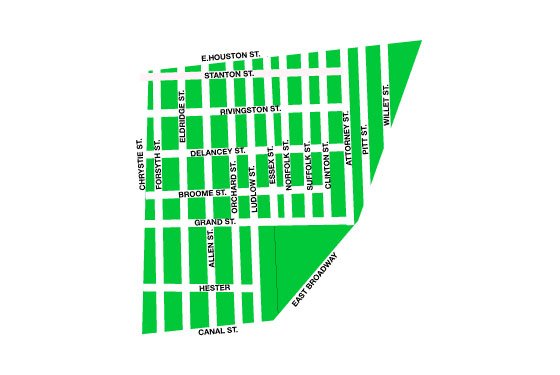
In its turn-of-the-century heyday, the Lower East Side was home to a flourishing Jewish community of Germans, Eastern Europeans, Russians, and Greeks. They lived in cramped tenements and peddled pushcarts or toiled in the garment industry for a living—when they weren’t agitating for social reform or establishing synagogues, community centers, Yiddish theaters, and newspapers. These days, the neighborhood has a different flavor. New waves of Chinese and Latino immigrants have set up their own shops, bodegas, and religious sites, converting defunct synagogues into churches and Buddhist temples. And though still an immigrant hub, the area is also decidedly hip, with pricey boutiques, swanky nightspots, and rising rents. But beneath the L.E.S.’s ever-changing identity, remnants of a gritty, tumultuous, and Jewish past remain.
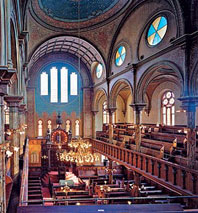
Eldridge Street Synagogue
12 Eldridge St., nr. Division St.; 212-219-0888; eldridgestreet.org
Now wedged between Chinese restaurants, fish markets, and hair salons, the resilient Eldridge Street Synagogue was designed and built more than a century ago by Jewish Eastern European immigrants. The synagogue opened in 1887, becoming the spiritual home for the first Eastern European Orthodox Jewish congregation in America. After years of makeshift gatherings in tenements, bakeries, and storefronts, New York City Jews flocked to Eldridge Street; crowds were so great that policeman patrolled the area on horseback during the high holy days when as many as 1,000 people might attend services. Today, the congregation is still active, celebrating the Sabbath and performing religious services in the basement beis midrash.
The façade and interior of the synagogue reflect an eclectic mix of Moorish, Romanesque, and Gothic influences: 70-foot vaulted ceilings, stained-glass windows, intricate carvings, and trompe l’oeil murals. In accordance with the old European tradition, the bimah (a platform from which the Torah is read) sits in the center of the sanctuary. Docents provide informal tours to handfuls of visitors who are welcome to wander, snap photos, or scan the tiny selection of postcards and topical books.
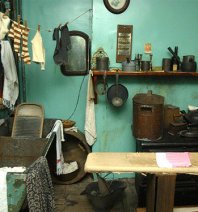
Lower East Side Tenement Museum
108 Orchard St., nr. Delancey St.; 212-431-0233; tenement.org
Wondering what those teeming tenements actually looked like? A guided tour is your only way into the Lower East Side Tenement Museum, a five-floor landmark built in 1863 whose apartments have been furnished to mimic the lives of former residents. Tour groups cluster in the narrow, dim, crumbling, and yet surprisingly ornate tenement entryway before heading upstairs to visit the apartments. Each apartment tour relates the tale of a different family. On one tour, the lives of garment workers are played out—from the birth of a shop owner’s son to a shiva call for a family mourning a garment presser felled by tuberculosis. On another, learn how the Gumpertz and Baldizzi families scraped by during the Great Depressions of 1873 and 1929. Hint: If you have kids, opt for the Confino Family tour where children are free to touch things, try on clothes, and pester the “costumed interpreter” who plays Victoria Confino, a teenage Sephardic Jew from Greece. Tour tickets are sold at the recently expanded gift shop, which also carries black-and-white historic postcards, journals, kids’ toys, hip souvenirs, and a slew of books on New York, cultural studies, urban studies, Judaica, travel, and cooking.
Kehila Kedosha Janina
280 Broome St., nr. Allen St.; 212-431-1619
The only Romaniote (Greek Jewish) synagogue left in the Western Hemisphere, Kehila Kedosha Janina struggles to keep alive the traditions and liturgy of its dwindling congregation. Distinct from Ashkenazim and Sephardim, Hellenized Jews were once scattered throughout the Mediterranean, absorbing and contributing to both Greek and Ottoman Turkish culture. A band of Jewish immigrants from the Greek village of Janina established the synagogue in 1927. Recently, their descendents have recorded prayers and excerpts from weekly services and have converted the balcony—traditionally reserved for women—into a simple, informative museum. Maps, posters, photographs, brochures, and a brief video trace the history of the Romaniotes. Docents are on hand to lead casual tours, share stories and recipes, and even ply visitors with the stash of cookies and soda kept in the basement. Don’t forget to poke around the sanctuary as well. The elaborate olive wood and metal tiks encasing the Torahs are uniquely Romaniote, as is the placement of the seats that run parallel along the sides of the bimah.
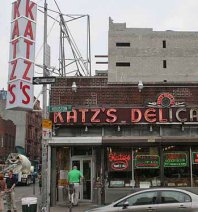
Katz’s Delicatessen
205 Houston St., nr. Ludlow St.; 212-254-2246; katzdelicatessen.com
Locals and tourists alike stream into big, bustling Katz’s Delicatessen, the oldest deli in New York (est. 1888) and the only one where the pastrami and corned beef are still hand-cut. Take a ticket upon entering and decide whether to wait for table service or to brave the lines, place your order with a wisecracking counterman, and watch him at work. A sign hangs from the ceiling pointing toward the table where Meg Ryan and Billy Crystal sat during the “I’ll have what she’s having” scene from When Harry Met Sally. Photos of celebrities and politicians plaster the walls; neon signs urge you to “Send a salami to your boy in the army” and boast “No connection with any other store.” Specialties include soft salami, liverwurst, knockwurst, knishes, frankfurters, and matzo-ball soup. A word of warning: This may be the bargain district, but the sandwiches aren’t cheap and they aren’t kosher either.
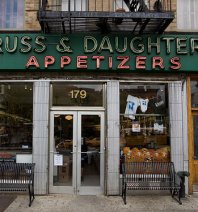
Russ & Daughters
179 E. Houston St., nr. Allen St.; 212-475-4880; russanddaughters.com
Dried fruits and nuts, chocolates, and cheeses line the shelves of the pristine specialty food shop Russ & Daughters, run by the Russes since 1914. Historic photographs above the counters suggest little inside the shop has changed. Fish is still the biggest draw—from the classic bagel and lox to nova, homemade pickled herring, and Caspian Sea caviar.
Angel Orensanz Foundation
72 Norfolk St., nr. Stanton St.; 212-529-7194; orensanz.org
The oldest synagogue building in the city had been shut down and systematically vandalized for over a decade when Spanish sculptor Angel Orensanz swooped in, purchasing the property in 1986 and converting it into an art studio. Now known as the Angel Orensanz Foundation, the synagogue was designed by Berlin-born architect Alexander Saelzer and intended to resemble Cologne Cathedral. The 54-foot-ceilinged structure could hold up to 1,500 worshippers and was the largest synagogue in the nation upon its 1849 opening. The Foundation continues to host shabbas services twice a month—in addition to its vast cultural programs—and is a popular spot for weddings and bar mitzvahs.
Streit’s Matzo Company
148-150 Rivington St., nr. Suffolk St.; 212-475-7000; streitsmatzos.com
Family-owned and operated for five generations, Streit’s Matzo Company is the last neighborhood matzo factory left. Step inside their kosher shop and peer through windows into the oven-filled space where all the matzos are made—lightly salted, egg and onion, whole wheat, and more. Ask around and chances are a family member will give you the tour.
Essex Street Market
120 Essex St., nr. Rivington St.; 212-388-0449; essexstreetmarket.com
Hoping to rid the streets of pushcart peddlers, Mayor Fiorello H. La Guardia set up this indoor market in 1939. Inside, Batista Grocery, Luis’s Meat Market, and many of today’s food, tchotchke, and clothing stands cater to Latino tastes. Exceptions include Schapiro’s Wines, an L.E.S. fixture since 1899 that sells kosher wines on weekdays, and a handful of gourmet purveyors like Saxelby Cheesemongers and Pain d’Avignon bakery.
Bialystoker Synagogue
7-11 Willett St., nr. Grand St.; 212-475-0165; bialystoker.org
Built in 1826, the Federal-style building originally housed a Methodist church and served as a stop on the Underground Railroad. A door along the balcony exposes a roughly 200-year-old ladder leading to an attic where Canada-bound slaves hid during the Civil War. In 1905, a congregation of Polish Jews from Bialystok converted the building into a synagogue, transporting a stunning, three-story ark from Italy. Paintings of zodiac symbols corresponding to Jewish calendar months span the sanctuary ceiling. Bialystoker offers frequent services to its 500-member congregation.
Beth Hamedrash Hagadol
60 Norfolk St., nr. Broome St.; 212-374-4100
Home of America’s oldest Orthodox Jewish Russian congregation, the synagogue remains a center of religious study and interpretation of Jewish law. Today, the Lower East Side and New York City preservation communities are working to restore the building to its original splendor.
East Broadway Landmarks
Take a detour along a quiet stretch of East Broadway, home to a handful of turn-of-the-century Jewish landmarks as well as a small, active Orthodox community. The imposing Forward Building (175 E. Broadway, at Canal St.) was once the headquarters of the Jewish Daily Forward, a Yiddish-language paper that promoted social reform while striving to expose its readers to American culture and customs. Down the block lies the Educational Alliance (197 E. Broadway, nr. Clinton St.; 212-780-2300; edalliance.org), a community center established in 1889 to provide immigrants with language and art classes, a free library, and help “Americanizing.” Keep heading north and you’ll hit Shteibl Row (E. Broadway, between Clinton and Montgomery Sts.), a series of former tenements converted into shuls where worshippers still gather. The nearby Henry Street Settlement (265 Henry St., nr. Montgomery St.; 212-766-9200; henrystreet.org), founded by social worker Lillian Wald in 1893, offers numerous educational and social services, while also contributing to the work of the Abrons Arts Center, a collection of theaters, art studios, and dance spaces found across the street.